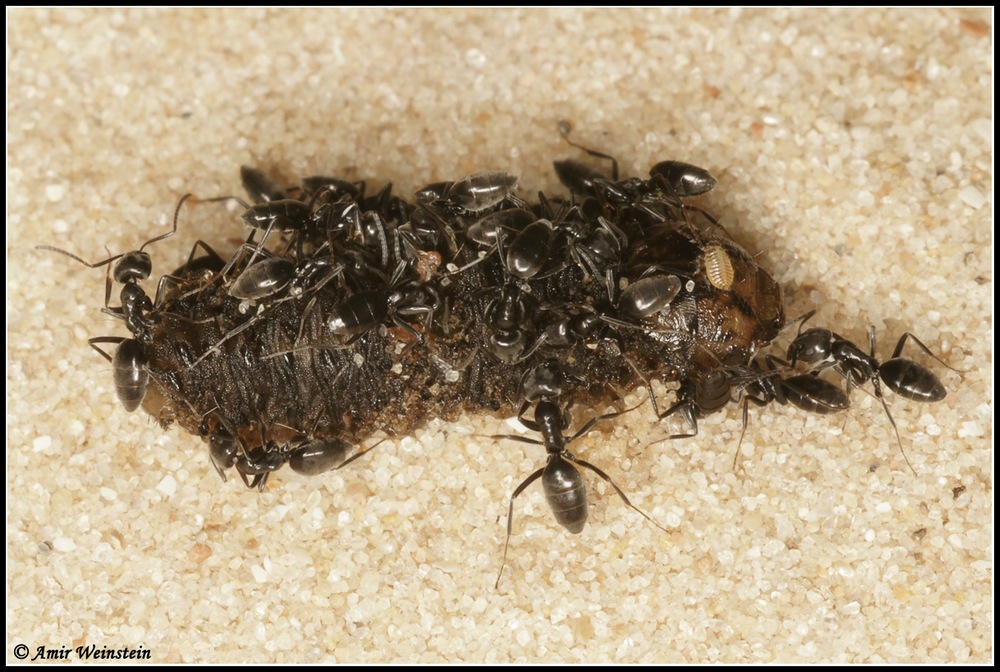|
|
|
|
|
Galleria Tassonomica
di
Natura Mediterraneo
|
|
|
| Autore |
 Discussione Discussione  |
|
|
Amir
Utente Senior
   

Città: Tel-Aviv
Regione: Israel

785 Messaggi
Tutti i Forum |
|
|
Hemerobius
Moderatore
   

Città: Alghero
Prov.: Sassari
Regione: Sardegna

4877 Messaggi
Flora e Fauna |
 Inserito il - 21 dicembre 2008 : 07:07:26 Inserito il - 21 dicembre 2008 : 07:07:26


|
Daer Amir,
your documentation is really good, as usual  ! !
And, as usual, your questions require time and meditation.
Caro Amir,
la tua documentazione è veramente buona, come al solito  ! !
E, come al solito, le tue domande richiedono tempo e riflessione.
| Messaggio originario di Amir:
Participants: Ants (Tapinoma sp) and unknown Homoptera nymphs need ID) |
In my opinion, they are Psyllids.
Secondo me sono delle Psille.
| The present of the camera lens so close to the ants press them and one ant take one nymph in the mandibles and move with the nymph to other location.
... The story become strange when i found (not far from the Tamarisk location) Tapinoma ants crowd on unlucky caterpillar (also normal behavior).
The surprise was to find the above unknown Homoptera nymph (one specimen) with the ants on the caterpillar (as seen in the next photo)
Immagine:
 |
An ant has certainly changed work  ! So the poor psyllid was dropped on caterpillar. ! So the poor psyllid was dropped on caterpillar.
Sicuramente una formica ha cambiato lavoro  ! Così la povera psilla è stata abbandonata sul bruco. ! Così la povera psilla è stata abbandonata sul bruco.
| The question is:
Is Tapinoma ants take/escort nymphs from much greater distance (dozens meters or more)? |
Yes, of course!
Sì, naturalmente!
| To make the issue more complicate I also found some nymph (same as found on the Tamarisk) walk on the sand, alone,exposed near other shrubs.
So maybe the ant just found wander nymph and "adopt" here as this is important property? |
The nymphs could walk on the sand just after an accidental fall ...
Le ninfe potrebbero camminare sulla sabbia dopo una caduta accidentale ...
Ciao Roberto 
verum stabile cetera fumus |
 |
|
|
elleelle
Moderatore Trasversale
    
Città: roma
Regione: Lazio

33251 Messaggi
Flora e Fauna |
 Inserito il - 11 luglio 2014 : 15:12:28 Inserito il - 11 luglio 2014 : 15:12:28


|
I think they are Tettigometridae (Hemiptera Fulgoromorpha).
As theese ones:
Link |
 luigi luigi |
 |
|
| |
 Discussione Discussione  |
|
|
|
 Natura Mediterraneo Natura Mediterraneo |
© 2003-2024 Natura Mediterraneo |
 |
|
Leps.it | Herp.it | Lynkos.net
|

 Forum
|
Registrati
|
Msg attivi
|
Msg Recenti
|
Msg Pvt
|
Utenti
|
Galleria |
Map |
Forum
|
Registrati
|
Msg attivi
|
Msg Recenti
|
Msg Pvt
|
Utenti
|
Galleria |
Map |